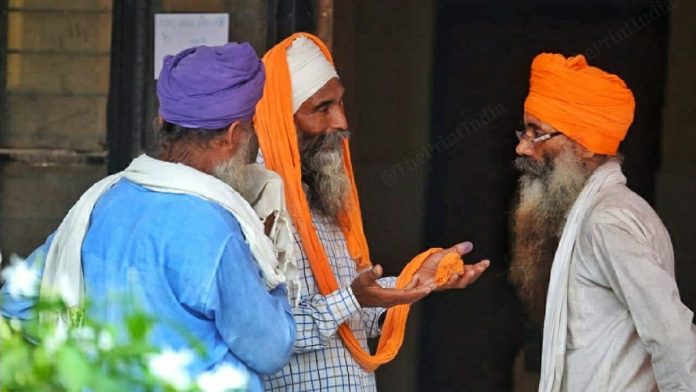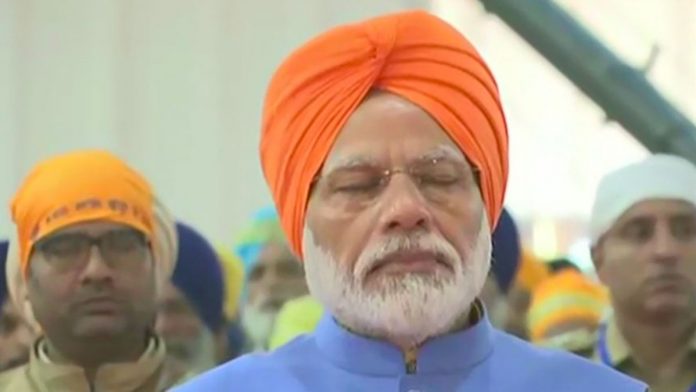Whenever India's farm sector was in jeopardy, Sikh-Punjabi farmers fought for their rights. The BJP underestimated them.

23 November, 2021 10:19 am IST


Sikhs in Lakhimpur Kheri, Uttar Pradesh (representational image) | Photo: Praveen Jain | ThePrint
The Sikh-Punjabi farmers are akin to the Tamil backward classes, who fought for OBC rights by bending the Delhi anti-reservation trends many times. When it comes to Dalit rights, it is the Maharastra Dalit forces who showed the way. Guru Nanak, Periyar Ramasamy, and Dr B.R Ambedkar thus created forces that are protecting our Constitution, democracy, and pluralism today.
The Sikh-Punjabi farmers are akin to the Tamil backward classes, who fought for OBC rights by bending the Delhi anti-reservation trends many times. When it comes to Dalit rights, it is the Maharastra Dalit forces who showed the way. Guru Nanak, Periyar Ramasamy, and Dr B.R Ambedkar thus created forces that are protecting our Constitution, democracy, and pluralism today.
The movement that spelt victory
Prime Minister Narendra Modi addressed the nation on Guru Nanak’s birthday, 19 November, and said that his government was withdrawing the three farm laws that it had enacted a year ago in Parliament. The Punjabi Sikh farmers declared a war against the laws in the thick of the second wave of Covid-19 and moved the farming fraternity to the borders of Delhi NCR. Their victory came after more than 700 farmers died since the start of the protests and several others were put in jail with all kinds of cases against them. A militant section of the Sikh farmers and the Nirankaris climbed the Red Fort in Delhi and declared an immature victory. Journalists and writers faced several cases and police beatings. Yet, the Rashtriya Swayamsevak Sangh (RSS) and the Bharatiya Janata Party (BJP) under the PM, appeared unmoved.
The RSS-BJP underestimated the Sikh conviction to fight for the rights of food-producing farmers. They seemed to have thought that the Sikhs would not understand what was happening. Agricultural produce was being handed over to the monopoly capitalists of India, who want to make immoral money in every sector of the economy and remain indifferent to poverty and suffering.
The anger against the government spread to the villages of Punjab, Haryana, and Uttar Pradesh. Subsequently, under the leadership of Bharatiya Kisan Union’s Rakesh Tikait, a massive non-Sikh farmer movement also came up. Villages in UP got drawn into the fight for survival in a big way. Finally, victory arrived. The PM had to bow before the annadata (food providers) with a big apology and repeal of the laws. However, there is a moral lesson for the Hindutva forces from Guru Nanak and the Sikh community that follows his teachings in the Guru Granth Sahib.
Also read: 5 reasons why farmers won the farm laws battle against Modi govt
Farming is God’s lifeblood: Guru Nanak
Guru Nanak’s teachings are different from that of the other guru who established the RSS in 1925, K.B. Hedgewar. The former formulated his spiritual ideas in a complex Hindu-Varna society under oppressive Muslim rule. Though he was born into the Hindu Bedi Khatri clan, in a Patwari family in 1469, he soon realised that agrarian production is the lifeblood of human survival, and God—he believed in one God—is the director of productive labour. God was not a war hero for him. A nation was not an arresting land unit of human narrowness. That is the reason why Guru Nanak’s followers went all over the world with labouring hands and worked in the fields and survived. They not only made Indian agriculture productive, but also made the same effort in countries such as Canada, the UK, and Australia. They never made their nationalism ‘anti-somebody.’
Though the Sikh farmers have 10 Gurus, Guru Nanak, the first, is the main guiding force of Sikhism. Whenever the nation’s farm sector was put in jeopardy by the Union government, Sikh-Punjabi farmers fought for their rights. Of course, this time they saved the nation and the Constitutional principle of federal democracy, which was being destroyed by the misuse of parliamentary majority to undermine Indian agriculture. But for their quick realisation of the danger, the country would have drifted from its constitutional path.
Also read: BJP leaders call farm laws repeal ‘bitter pill’ but foresee better prospects in UP, Punjab
The ‘anti-anything’ ideology of the RSS
Hedgewar, on the other hand, built an organisation that wants to be seen agreeing with the Constitution, democracy, and pluralism, but in practice, goes in the opposite direction. Guru Nanak never set a spiritual or social ideology of anti-anything, whereas Hedgewar set ‘anti-Muslim,’ ‘anti-beef and meat,’ and ‘anti-equality’ ideologies in the name of Hindu dharma and parampara (tradition). Now, farmers have stopped the Hindutva juggernaut. The nation will salute the Sikh farmers who resisted the might of the government, and saved the agrarian sector of India.
Sikhs in India also have a religion-centred political party, the Akali Dal. It works on the ideological principles that the Sikh Gurus put in place. But in its known history, it never went against other religious communities in Punjab. It never interfered with the food rights of any community in the state. It never stopped women between the ages of 12 and 50 from entering gurdwaras, unlike the RSS, who in 2018 asked the temple authorities to ‘respect the tradition’ that banned the entry of women into the Ayyappa temple in Kerala. On the question of human rights, the people of Punjab never felt the difference between the Congress and the Akali Dal, despite the differences in their economic and administrative agendas. Such differences are acceptable in a constitutional democracy.
But now, not just India, but the whole world sees the difference between Congress and BJP rules when it comes to human rights despite their pledge to the same Constitution. Not that I have forgotten the Emergency of Indira Gandhi’s time. But that was fought by all of us and the Punjabi Sikh farmers did not spare their might in fighting it.
Also read: Why the farmers’ protest is led by Sikhs of Punjab
Sikhism has a lesson to teach every religion
Spiritual morality must move through politics to establish an egalitarian society and not a divisive one. The farmers’ movement and its victory gave new confidence to the nation in a depressive situation. For the last one year, the whole world was watching the unending movement. At last, the RSS and the BJP realised that this movement would continue till its victory.
The Sikh farmers’ movement in Delhi showed the world how peaceful the Sikhs were, how they fed every hungry person in their gurdwaras, including the police personnel who beat them on the roads. That is the grace they acquired from Guru Nanak. Within India, the Sikh farmers have shown that each religion must respect other religions and ways of living. More than anything, they showed that religion is meant to increase production through labour in the fields. This is a lesson that all other religions of India must learn from Sikhs and their Gurus. No food producer should be judged by one who does not produce. The farmers, who fought this battle and won, have written history.
Kancha Ilaiah is an academic, writer, social scientist, and Dalit rights activist. Views are personal.
(Edited by Humra Laeeq)
xxxxxxxxxxxxxxxxxxxx
The symbolism is obvious. PM Modi's farm laws repeal came on Gurpurab, and RSS chief Mohan Bhagwat was at a gurdwara.

File photo | Prime Minister Narendra Modi at Dera Nanak Saheb in Punjab | Photo: ANI
The symbolism was too profound to be missed. Prime Minister Narendra Modi’s announcement to repeal the three contentious farm laws came on the occasion of Guru Nanak Jayanti on 19 November.
The symbolism was too profound to be missed. Prime Minister Narendra Modi’s announcement to repeal the three contentious farm laws came on the occasion of Guru Nanak Jayanti on 19 November.
It may be a coincidence, but on the same day, the Rashtriya Swayamsevak Sangh chief Mohan Bhagwat went to a gurdwara in Chhattisgarh’s Raipur and paid obeisance.
The Prime Minister’s announcement has been generally seen and analysed in the context of impending assembly elections in the states of Punjab and Uttar Pradesh in 2022. The popular theory is that the farmers’ movement was causing damage to the electoral prospects of the Bharatiya Janata Party (BJP), and the PM was forced to take a U-turn on the farm laws. Even farmer leaders have been saying that. Such analyses were made despite the fact that Punjab has never been an electorally important territory for the BJP, and in UP, the movement was limited to half-a-dozen districts in the western and terai regions, where Sikh farmers were allotted land after Partition in 1947.
It’s true that assembly elections are just around the corner, and the PM’s decision can impact the electoral arithmetic, but I would like to argue that the government’s move is more social, cultural, and ideological than electoral. It has been done to safeguard something that is most important for the Hindutva brigade—the ‘idea of Hindutva’ itself as envisioned by V.D. Savarkar. In effect, the BJP (and the RSS) took the decision to repeal the farm laws to tell the Sikhs that they are not ‘another Muslim’ for them.
Also read: Gandhi is back. Farm laws repeal shows even the most hostile enemy can be transformed
Sikhs, Hindutva and Savarkar
Sikhs are very important within Hindutva narratives, and the RSS and the BJP cannot afford to treat them like they treat Muslims. The latter’s othering is not just acceptable, but also essential to the idea of Hindutva.
In his book Essentials of Hindutva, V.D. Savarkar constantly argued that “If any community in India is Hindu beyond cavil or criticism, it is our Sikh brotherhood in the Punjab, being almost the autochthonous dwellers of the Sapta Sindhu land and the direct descendants of the Sindhu or Hindu people. The Sikh of today is the Hindu of yesterday, and the Hindu of today may be the Sikh of tomorrow. The change of a dress, or a custom, or detail of daily life cannot change the blood or the seed, nor can efface and blot out history itself.”
This shows the importance that Savarkar ascribed to the idea that Sikhs should remain within the Hindu fold. At the time of writing this book, his project was to create a grand Hindutva narrative, and he wanted to club the Sanatanists, Satnamis, Sikhs, Aryas, Anaryas, Marathas and Madrasis, Brahmins and Panchamas (‘untouchables’) under the Hindutva fold.
So, Savarkar sounded more progressive than Gandhi, who held puritanical views on caste and varna. Savarkar said, “The system of four varnas may disappear when it has served its end or ceases to serve it, but will that make our land a Mlechchadesha—a land of foreigners? The Sanyasis, the Arya Samajis, the Sikhs and many others do not recognise the system of the four castes, and yet are they foreigners? God forbid! They are ours by blood, by race, by country, by God. We, Hindus, are all one and a nation, because chiefly of our common blood: Bharati Santati.”
In Essentials of Hindutva, Savarkar used the word ‘Sikh’ more than 60 times. This number is another way to understand the importance of Sikhs in his Hindutva project. He further said that Sikhs should continue to profess their religion and continue to fight for minority rights. He added, “The Sikhs are free to reject any or all superstitions they dislike in sanatan dharma,” even the binding authority of the Vedas as a revelation. They, thereby, may cease to be Sanatanis, but cannot cease to be Hindus. “Sikhs are Hindus in the sense of our definition of Hindutva and not in any religious sense whatever,” said Savarkar.
Also read: ‘Punjabis don’t forget easily’ — farmers in Punjab cheer repeal but no props for Modi
The Prime Minister’s announcement has been generally seen and analysed in the context of impending assembly elections in the states of Punjab and Uttar Pradesh in 2022. The popular theory is that the farmers’ movement was causing damage to the electoral prospects of the Bharatiya Janata Party (BJP), and the PM was forced to take a U-turn on the farm laws. Even farmer leaders have been saying that. Such analyses were made despite the fact that Punjab has never been an electorally important territory for the BJP, and in UP, the movement was limited to half-a-dozen districts in the western and terai regions, where Sikh farmers were allotted land after Partition in 1947.
It’s true that assembly elections are just around the corner, and the PM’s decision can impact the electoral arithmetic, but I would like to argue that the government’s move is more social, cultural, and ideological than electoral. It has been done to safeguard something that is most important for the Hindutva brigade—the ‘idea of Hindutva’ itself as envisioned by V.D. Savarkar. In effect, the BJP (and the RSS) took the decision to repeal the farm laws to tell the Sikhs that they are not ‘another Muslim’ for them.
Also read: Gandhi is back. Farm laws repeal shows even the most hostile enemy can be transformed
Sikhs, Hindutva and Savarkar
Sikhs are very important within Hindutva narratives, and the RSS and the BJP cannot afford to treat them like they treat Muslims. The latter’s othering is not just acceptable, but also essential to the idea of Hindutva.
In his book Essentials of Hindutva, V.D. Savarkar constantly argued that “If any community in India is Hindu beyond cavil or criticism, it is our Sikh brotherhood in the Punjab, being almost the autochthonous dwellers of the Sapta Sindhu land and the direct descendants of the Sindhu or Hindu people. The Sikh of today is the Hindu of yesterday, and the Hindu of today may be the Sikh of tomorrow. The change of a dress, or a custom, or detail of daily life cannot change the blood or the seed, nor can efface and blot out history itself.”
This shows the importance that Savarkar ascribed to the idea that Sikhs should remain within the Hindu fold. At the time of writing this book, his project was to create a grand Hindutva narrative, and he wanted to club the Sanatanists, Satnamis, Sikhs, Aryas, Anaryas, Marathas and Madrasis, Brahmins and Panchamas (‘untouchables’) under the Hindutva fold.
So, Savarkar sounded more progressive than Gandhi, who held puritanical views on caste and varna. Savarkar said, “The system of four varnas may disappear when it has served its end or ceases to serve it, but will that make our land a Mlechchadesha—a land of foreigners? The Sanyasis, the Arya Samajis, the Sikhs and many others do not recognise the system of the four castes, and yet are they foreigners? God forbid! They are ours by blood, by race, by country, by God. We, Hindus, are all one and a nation, because chiefly of our common blood: Bharati Santati.”
In Essentials of Hindutva, Savarkar used the word ‘Sikh’ more than 60 times. This number is another way to understand the importance of Sikhs in his Hindutva project. He further said that Sikhs should continue to profess their religion and continue to fight for minority rights. He added, “The Sikhs are free to reject any or all superstitions they dislike in sanatan dharma,” even the binding authority of the Vedas as a revelation. They, thereby, may cease to be Sanatanis, but cannot cease to be Hindus. “Sikhs are Hindus in the sense of our definition of Hindutva and not in any religious sense whatever,” said Savarkar.
Also read: ‘Punjabis don’t forget easily’ — farmers in Punjab cheer repeal but no props for Modi
Sikhs sustained the farmers’ protests
On the face of it, one may postulate that the farmers’ movement was a non-religious social movement, as many of its leaders were Hindus and even Muslims such as Hannan Mollah, the general secretary of the All India Kisan Sabha.
Farmers from all religious groups took part in the movement and their demands were all economic and related to government policies. The organisers took extra effort to ensure that the movement doesn’t look like a religious programme by making Hindu and Muslim leaders a part of all the delegations and press conferences.
But the fact remains that the Sikhs were at the core of the movement, and the religious overtones were never missed. The protests started in Punjab just after the three Bills were passed in Parliament in mid-September 2020. The state government, led by the Congress, supported the farmers’ agitation and the Punjab assembly even passed a resolution that the Acts would not be implemented in the state. The principal opposition party in Punjab, the Akali Dal, also took the same position. For two months, the farmers’ unions protested, blocking roads and rail networks. All this while the movement remained largely confined to the Sikh farmers. Later on, Hindu Jats also joined the agitation. Other communities soon became a part of the protests, but these two were at the core. A vast majority of the farmers who died during the protests were Sikhs.
In November 2020, the farmers gave a call to march to Delhi, and farmers from Haryana and western UP became a part of the agitation as well. Despite the movement broad-basing its social structure, the Sikhs exerted the strongest influence on it. The Sikh religious and philanthropic organisations provided it with the necessary infrastructure. The gurdwaras and the prabandhak (managing) committees organised the community kitchens, medical facilities and also functioned as transit points for farmers travelling to and fro. Makeshift gurdwaras were made and Nihang Sikhs provided security to the agitators. Sikh organisations and leaders in the West made it global—Sikh Members of Parliament (MPs) in the UK and Canada raised their issues in their respective parliaments. The community’s diaspora received such massive support that the Modi government was compelled to intervene, and therefore, it started investigating the so-called ‘toolkit’. Interestingly, despite all the efforts of Indian Muslims abroad, the protests against the Citizenship (Amendment) Act and the National Register of Citizens (NRC) never got such international support.
An impression was created—part of it may be by design—that the government is suppressing the Sikhs. This, the BJP never wanted. Alienating Sikhs beyond a point is antithetical to the idea of Hindutva and the RSS, so the BJP finally decided to go for reconciliation.
Also read: Guru Nanak vs RSS guru Hedgewar—farmer protests showed how Sikhs have a lesson for India
But the fact remains that the Sikhs were at the core of the movement, and the religious overtones were never missed. The protests started in Punjab just after the three Bills were passed in Parliament in mid-September 2020. The state government, led by the Congress, supported the farmers’ agitation and the Punjab assembly even passed a resolution that the Acts would not be implemented in the state. The principal opposition party in Punjab, the Akali Dal, also took the same position. For two months, the farmers’ unions protested, blocking roads and rail networks. All this while the movement remained largely confined to the Sikh farmers. Later on, Hindu Jats also joined the agitation. Other communities soon became a part of the protests, but these two were at the core. A vast majority of the farmers who died during the protests were Sikhs.
In November 2020, the farmers gave a call to march to Delhi, and farmers from Haryana and western UP became a part of the agitation as well. Despite the movement broad-basing its social structure, the Sikhs exerted the strongest influence on it. The Sikh religious and philanthropic organisations provided it with the necessary infrastructure. The gurdwaras and the prabandhak (managing) committees organised the community kitchens, medical facilities and also functioned as transit points for farmers travelling to and fro. Makeshift gurdwaras were made and Nihang Sikhs provided security to the agitators. Sikh organisations and leaders in the West made it global—Sikh Members of Parliament (MPs) in the UK and Canada raised their issues in their respective parliaments. The community’s diaspora received such massive support that the Modi government was compelled to intervene, and therefore, it started investigating the so-called ‘toolkit’. Interestingly, despite all the efforts of Indian Muslims abroad, the protests against the Citizenship (Amendment) Act and the National Register of Citizens (NRC) never got such international support.
An impression was created—part of it may be by design—that the government is suppressing the Sikhs. This, the BJP never wanted. Alienating Sikhs beyond a point is antithetical to the idea of Hindutva and the RSS, so the BJP finally decided to go for reconciliation.
Also read: Guru Nanak vs RSS guru Hedgewar—farmer protests showed how Sikhs have a lesson for India
A tense reconciliation
One may ask why it took so much time for the BJP to reach this conclusion because the religious character of the farmers’ movement was quite visible from the very beginning. My explanation is that it was a miscalculation. There was a conflict between the economic agenda and the ideological core, so the BJP took some time to make a decision. We don’t know for sure, but a minor incident in Gurugram might have triggered it. There was a dispute over Friday Namaz at a public ground, and it was reported that the Sadar Bazar Gurdwara Association in Gurugram opened up their premises to Muslims to offer Namaz. Though the Namaz inside the gurdwara compound didn’t happen, but just the idea of Sikhs and Muslims coming together might have shaken up the BJP and the RSS.
In early 2020, such solidarity was clearly expressed during the CAA-NRC protests at Shaheen Bagh in Delhi, where Sikh farmers set up langar to provide freshly cooked food to the protesters.
The Sikh core of the farmers’ movement and their alienation rattled the BJP and the RSS, whom we might see reaching out to Sikhs in more ways in the coming days.
The author is the former managing editor of India Today Hindi Magazine and has written books on media and sociology. He tweets @Profdilipmandal. Views are personal.
(Edited by Humra Laeeq)
Subscribe to our channels on YouTube & Telegram
